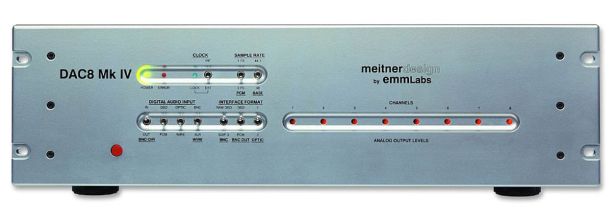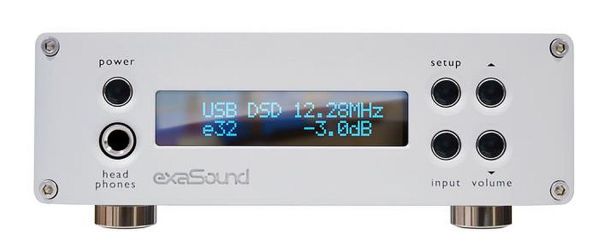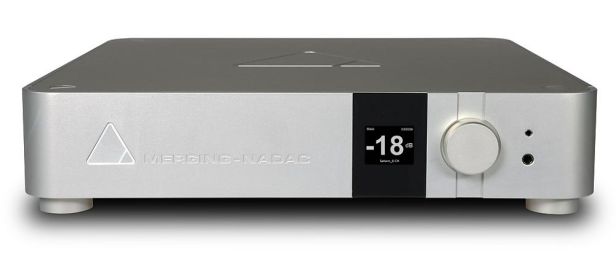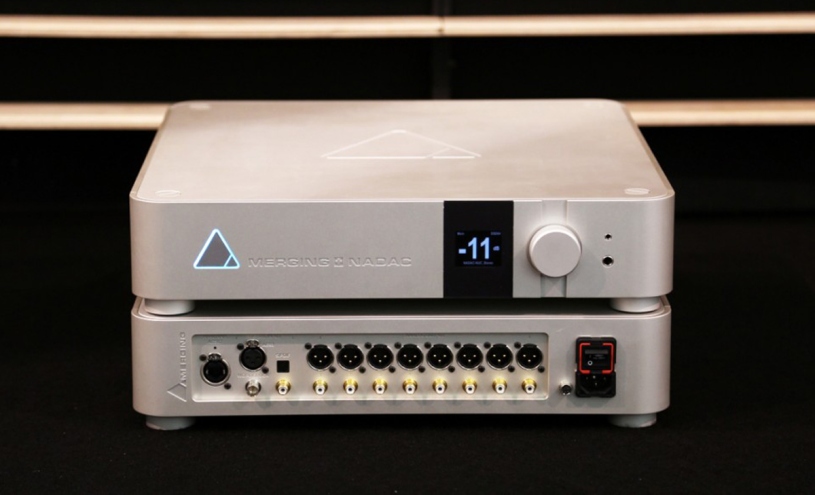In the first part of this article, I discussed a system based around a multichannel sound card. By far the more straightforward option is to simply connect your PC to a multichannel DAC, and from there to multiple power amplifiers, like this:

This is a brief survey of the various multichannel DAC’s on the market. Note that I do not have direct experience with some of these DAC’s. In those cases, I make my observations based on the spec sheets only, and I have deliberately refrained from making any remarks on the functionality and performance of the DAC unless I have direct experience with it.
This is by no means an exhaustive list. Not included are a large number of pro audio DAC’s which would also be suitable. The somewhat arbitrary criteria for inclusion in this list is that it must include connectors common to home audio systems. If you choose a pro audio DAC, you will need an adapter or breakout cable to be able to use it with your home system.

EMM Labs DAC8 Mk.IV $8500
Link. Designed by Ed Meitner, one of the founding fathers of DSD. The DAC8 Mk.IV accepts input via SPDIF or AES/EBU, and has 8 channels of analog output via XLR only. It also has word clock input/output BNC connectors. It converts PCM (up to 96kHz) and DSD (up to DSD128) to analog. The output voltage is not supplied in the spec sheet.
I have not heard this particular DAC, but I have heard other EMM Labs DAC’s. They seem to have a rather dry but detailed sound, almost as if the DAC is trying to impress you with how much detail it is able to retrieve.

ExaSound E28 / E38 $3299 / $3849
Link. The E28 is an older, superseded model that uses the Sabre ESS 9018 chip. The E38 is the current model which uses a single Sabre ESS 9038. The Sabre 900x family of chips (9008/9018/9028/9038) are single DAC chips which is capable of 8 channels of input and output simultaneously. Both models of Exasound are 8 channel DAC’s which accept digital input via SPDIF or USB. The older E28 could be ordered with either RCA outputs or mini-XLR outputs (which was somewhat inconvenient, given the rarity of this type of connector). The newer E38 has RCA outputs only, although the manufacturer says that mini-XLR is an option via a special order. It is capable of converting PCM (up to 384kHz) and DSD (up to DSD256). The line output level is somewhat low at 2.2V RMS.
Reviews. I have no personal experience with this DAC, or any other Exasound products.

Illusonic IAP-8 / $21300
Link. Strictly speaking, this is a DSP processor rather than an 8 channel DAC (the IAP stands for Immersive Audio Processor), but it can be used as an 8 channel DAC if you wanted to – although that eye watering price would suggest that most of your money has gone to pay for the processor, so it would be somewhat of a waste to use it as an 8 channel DAC! It accepts input via Ethernet, USB, SPDIF, HDMI, and has an ADC so it can also accept analog and phono. Output is via 8 XLR’s. Stereophile review.

Merging NADAC MC-8 / NADAC Player $11,500 / $14,000
Link. Merging is currently the market leader in DSD analog to digital converters in the pro market. Chances are, if you are listening to a recording made in DSD, it was recorded using equipment supplied by Merging. This is their first entry into the consumer market, and it has received rave reviews so far. Input is via AES or SPDIF, but the best way to connect to the NADAC is via Ethernet, via Merging’s proprietary Ravenna protocol. “NADAC” stands for “Network Attached DAC” after all. Note, there is no USB input. The NADAC MC-8 uses two Sabre ESS9008 DAC chips. You might note that a mass market Oppo DVD player which sells for less than 1/10 the price of the NADAC uses the 9008’s big brother – the 9018.
The NADAC uses a switch mode power supply. It does have a 12V DC input, but it uses a rather difficult to find Hirose connector. After I went through a lot of trouble to get a custom cable made, I found that using an Uptone Audio Linear PSU substantially improved the sound of the NADAC. A standard NADAC sounds relatively polite but with a slight upper frequency sibilance. With the Uptone LPSU, it suddenly comes alive with much better dynamics and much better timbre.
If we are talking about the 2 channel version of the NADAC, it is massively outclassed in the market segment it competes in (DAC’s costing $10k and up). In this market, you will find proprietary or programmable DAC’s (DCS Ring DAC, MSB ladder DAC, Playback Designs FPGA-based AKDesigns DAC, etc) where the NADAC uses an off-the-shelf chip, and the cheapest off-the-shelf chip they could find at that. Other DAC’s use toroidal PSU’s, with some of them providing a separate PSU for each channel (Bricasti, MSB, Playback). The NADAC? A switch mode power supply, the same as your phone charger. Other DAC manufacturers separate the analog and digital sections, while the NADAC has everything on the same board. Oh, and lastly, the output stage. The NADAC uses a single measly op-amp per channel. They couldn’t even bring themselves to put a pair of op-amps to provide true balanced output. They do this, while the competition is boasting discrete output stages which are as good as some preamps.
When I compared the NADAC to my 8 year old Playback Designs MPS-5, the newer NADAC was soundly trashed by the older DAC. You would think that a premium DAC produced in 2016 should be able to outclass something built in 2008. Perhaps it would have, if Merging had paid more attention to what other high end manufacturers are doing. A hint for Merging: using cut price components does not cut it in the market segment you are trying to compete in. You should either supply the components expected of a DAC that sells for this price, or cut the price of the NADAC to something more suitable. Perhaps $5000 would be a more reasonable price point.
It is massively disappointing that Merging built this product with evidence of cost cutting evident everywhere. Sadly, it is also the best available multichannel DAC in the market at this time without costing silly money.

MSB Theatre Master DAC / $124,995
Link. There is one specification about this DAC that stands out among all other DAC’s in this list. The price. It is absolutely crazy. Still, if you are an oil sheikh, the Sultan of Brunei, or the only son of a Chinese politician, you could probably afford it.
The MSB is able to accept a number of different types of inputs, depending on which overpriced module you decide to install. Seriously, check out the pricing page – the input module alone costs $3995, enough to buy you an Exasound E38 with change left over! One optional power base by itself costs nearly as much as a Merging NADAC. Given that there is no magic in engineering a power supply, one has to wonder why they charge so much for it.
I have not heard this DAC, but I have heard it’s cheaper brother, a DAC V (still not cheap at about AUD$65,000). It impresses with its liquid smoothness and tremendous inner detail. As much detail as the EMM Labs, but without the dryness.

Prism ADA-8XR $11,935
Link. As you can tell from the appearance, this is a pro audio product. However, it does have 8 XLR analog outputs so it qualifies for inclusion on my list. It is able to perform 8 channels of analog to digital conversion, and has 8 XLR inputs as well. Connection to your computer is via Firewire. I have no personal experience with this product, nor am I aware of anybody using it in an active crossover configuration.

